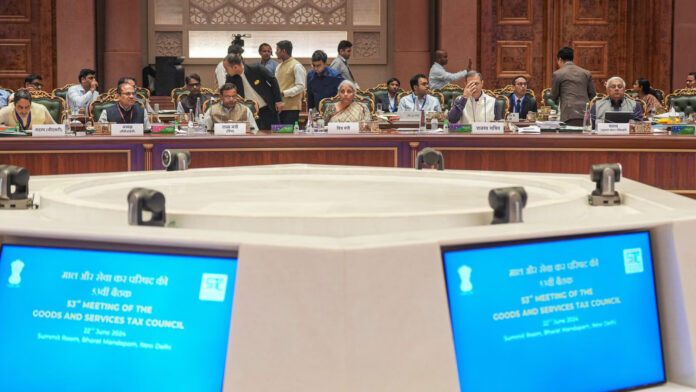July marks the seventh anniversary of the Goods and Services Tax (GST) in India, a landmark economic reform since the liberalization policies of 1991. GST was designed to unify the tax system by consolidating various state and central taxes, thereby creating a single market across the country. The aim was to streamline the tax structure, making it easier for businesses and consumers by eliminating the complexities of state-specific taxes. Despite these ambitious goals, GST continues to be a source of tension between the Centre and the states, revealing deep-seated challenges in India’s federal structure.
The Promise of GST
When GST was introduced in July 2017, it was celebrated as a revolutionary step that would simplify taxation, boost compliance, and increase the overall tax base. By bringing goods and services under a single tax regime, GST aimed to eliminate the cascading effect of taxes, where a product would be taxed multiple times at different stages of the supply chain. This was expected to reduce the overall tax burden on consumers and promote ease of doing business in India.
The GST Council, which includes representatives from both the Centre and the states, was established to ensure collaborative decision-making. This cooperative federalism was intended to address the concerns of states regarding revenue loss and ensure a smooth transition to the new tax system.
Centre-State Dynamics and Revenue Concerns
Despite the cooperative framework, GST has been a contentious issue between the Centre and the states. One of the primary points of contention is the revenue shortfall and the compensation mechanism. When GST was implemented, states were promised compensation for any revenue loss arising from the transition to GST for a period of five years. This assurance was crucial in getting states on board with the reform.
However, as economic conditions fluctuated and GST collections fell short of expectations, states began to express concerns about delayed and insufficient compensation payments. The COVID-19 pandemic exacerbated these issues, causing a significant decline in economic activity and, consequently, GST revenues. The Centre’s inability to fully compensate states on time led to a breach of trust and heightened tensions.
Structural Challenges and Rate Rationalization
The GST structure itself has been a subject of ongoing debate. Initially, GST was introduced with four primary tax slabs (5%, 12%, 18%, and 28%), along with several exemptions. While this multi-rate structure aimed to balance revenue needs with socio-economic considerations, it added complexity to the system. Businesses often struggled with compliance, and frequent changes in tax rates and classifications added to the uncertainty.
Efforts to rationalize GST rates have faced resistance from both the Centre and states due to differing priorities. States often argue that lowering tax rates on essential goods can lead to significant revenue loss, impacting their ability to fund public welfare schemes. On the other hand, the Centre pushes for a broader tax base and higher compliance.
The Issue of Fiscal Autonomy
GST has also reignited the debate on fiscal autonomy for states. Before GST, states had the power to levy and collect taxes on goods within their jurisdictions. This autonomy allowed states to tailor their tax policies to their specific economic conditions and developmental priorities. With GST, states have ceded a significant portion of their tax authority to the Centre, leading to concerns about reduced fiscal independence.
The periodic need to negotiate tax rates and exemptions in the GST Council underscores the delicate balance of power. States often feel that their interests are secondary to those of the Centre, especially when it comes to decisions that have significant revenue implications.
The Role of Technology and Compliance
The GST reform brought with it the promise of a robust technology-driven compliance system. The Goods and Services Tax Network (GSTN) was established to manage the entire GST ecosystem, including registration, return filing, and tax payment. While the use of technology aimed to simplify processes and enhance transparency, its implementation has been fraught with challenges.
Businesses, particularly small and medium enterprises (SMEs), have faced difficulties adapting to the digital filing requirements. Technical glitches, frequent updates, and complex return filing procedures have led to compliance burdens. Although measures have been taken to streamline the process, these initial hurdles have contributed to the perception that GST is more cumbersome than beneficial.
Moving Forward: Need for Cooperative Federalism
As India commemorates the seventh anniversary of GST, it is clear that while the reform has achieved significant milestones, it has also revealed the complexities of India’s federal structure. The ongoing Centre-state friction highlights the need for more robust mechanisms to address the concerns of states and ensure a more equitable distribution of tax revenues.
Moving forward, enhancing the efficiency of the GST Council is crucial. Ensuring timely and adequate compensation to states, simplifying the tax structure, and addressing compliance challenges through better technology integration are essential steps. Moreover, fostering a spirit of cooperative federalism, where the Centre and states work collaboratively towards common economic goals, will be key to the long-term success of GST.
The introduction of GST was a bold step towards creating a unified market in India, simplifying the tax structure, and promoting economic growth. However, the persistent friction between the Centre and states underscores the challenges of implementing such a sweeping reform in a diverse and federal country like India.
As the nation reflects on seven years of GST, it is evident that while significant progress has been made, there is still much to be done. Addressing the revenue concerns of states, simplifying the tax regime, and improving compliance mechanisms will be critical in ensuring that GST fulfills its promise of being a game-changer for India’s economy. The journey towards a seamless, efficient, and equitable GST system requires continuous effort, mutual understanding, and a commitment to cooperative federalism.
Disclaimer: The thoughts and opinions stated in this article are solely those of the author and do not necessarily reflect the views or positions of any entities represented and we recommend referring to more recent and reliable sources for up-to-date information.



